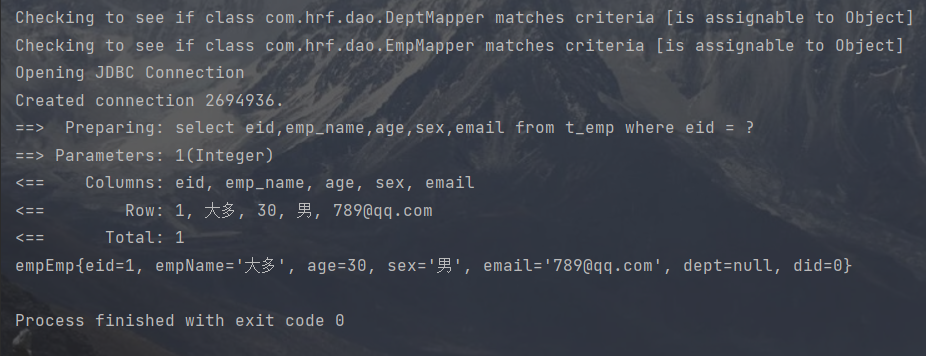Mybatis-动态SQl
简介:Mybatis框架的动态SQL技术是一种根据特定条件动态拼装SQL语句的功能,它存在的意义是为了解决 拼接SQL语句字符串时的痛点问题。
标签一:
if
if标签可通过test属性的表达式进行判断,若表达式的结果为true,则标签中的内容会执行;反之标签中 的内容不会执行
mapper文件:
<!--动态sql之if标签 List<Emp> getEmpListByMoreTj(Emp emp); if标签中test属性:表示判断条件(条件满足才会执行对应的sql语句) --> <select id="getEmpListByMoreTj" resultType="emp"> select * from t_emp where 1=1 <if test="empName !=null and empName!=''"> and empName = #{empName} </if> <if test="age != '' and age!=null"> and age = #{age} </if> <if test="sex != '' and sex != null"> and sex = #{sex} </if> </select>
其中where后面跟的1=1是为了跟好的拼接sql语句,如果没有第一个if标签生效 sql会出现错误p
标签二:
where
where和if一般结合使用:a>若where标签中的if条件都不满足,则where标签没有任何功能,即不会添加where关键字
b>若where标签中的if条件满足,则where标签会自动添加where关键字,并将条件最前方多余的 and去掉
(注意:where标签不能去掉条件最后多余的and ,只能取出前方的多余的and)
<!--动态sql之where标签--> <select id="getEmpListByMoreTj" resultType="emp"> select * from t_emp <where> <if test="empName !=null and empName!=''"> empName = #{empName} </if> <if test="age != '' and age!=null"> and age = #{age} </if> <if test="sex != '' and sex != null"> and sex = #{sex} </if> </where> </select>
标签三:
trim
trim用于去掉或添加标签中的内容
常用属性:(条件成立时)prefix:在trim标签中的内容的前面添加某些内容
prefixOverrides:在trim标签中的内容的前面去掉某些内容
suffix:在trim标签中的内容的后面添加某些内容
suffixOverrides:在trim标签中的内容的后面去掉某些内容
<!--动态sql之trim标签--> <select id="getEmpListByMoreTrim" resultType="emp"> select * from t_emp <trim prefix="where" suffixOverrides="and"> <if test="empName !=null and empName!=''"> empName = #{empName} and </if> <if test="age != '' and age!=null"> age = #{age} and </if> <if test="sex != '' and sex != null"> sex = #{sex} </if> </trim> </select>
标签四:
choose、when、otherwise
choose、when、otherwise相当于if...else if..else(当条件有一个满足时其他条件就不会再去判断)
when至少有一个,otherwise最多有一个
<!--动态sql之choose,when.otherwise标签--> <select id="getEmpListByMoreTrim" resultType="emp"> select * from t_emp <where> <choose> <when test="empName !=null and empName!=''"> empName = #{empName} </when> <when test="age != '' and age!=null"> age = #{age} </when> <when test="sex != '' and sex != null"> sex = #{sex} </when> <otherwise> did = 1; </otherwise> </choose> </where> </select>
标签五:
foreach:
属性:
collection:设置要循环的数组或集合
item:表示集合或数组中的每一个数据
separator:设置循环体之间的分隔符(会自动在sql语句中分隔符前后加入空格)
open:设置foreach标签中的内容的开始符
close:设置foreach标签中的内容的结束符
通过foreach标签进行批量删除操作:
定义接口方法:
/** * 通过数组实现批量删除 */ int deleteMoreByArray(@Param("eids") int[] eids);
mapper文件:
<!--int deleteMoreByArray(@Param("eids") int[] eids);--> <delete id="deleteMoreByArray"> delete from t_emp where eid in <foreach collection="eids" item="eid" separator="," open="(" close=")"> #{eid} </foreach> </delete>
通过foreach标签进行批量添加操作:
定义接口方法:
/** * 通过List集合实现批量添加 */ int insertMoreEmp(@Param("emps") List<Emp> emps);
mapper文件:
<!--int insertMoreEmp(List<Emp> emps);--> <insert id="insertMoreEmp"> insert into t_emp values <foreach collection="emps" item="emp" separator=","> (null,#{emp.empName},#{emp.age},#{emp.sex},#{emp.email},null) </foreach> </insert>
测试类方法:
@Test public void insertMoreEmp(){ SqlSession sqlSession = MybatisUtils.getSqlSession(); EmpMapper mapper = sqlSession.getMapper(EmpMapper.class); Emp emp1 = new Emp(5,"张三",20,"男","1859@qq.com"); Emp emp2 = new Emp (6,"里斯",23," 女","2859@qq.com"); List<Emp> emps = Arrays.asList(emp1,emp2); int i = mapper.insertMoreEmp(emps); System.out.println(i); }
标签六:
SQL片段
sql片段,可以记录一段公共sql片段,在使用的地方通过include标签进行引入
设置sql片段:<sql id="empColumns">eid,emp_name,age,sex,email(设置要拼接的内容)</sql> id属性设置sql片段的名称
引用sql片段:<include refid="empColumns"></include> 通过id属性引用sql片段
定义接口方法:
Emp selectEmpById(@Param("eid")int eid);
mapper文件:
<sql id="empColumns">eid,emp_name,age,sex,email</sql> <!--Emp selectEmpById(@Param("eid")int eid);--> <select id="selectEmpById" resultType="emp"> select <include refid="empColumns"></include> from t_emp where eid = #{eid} </select>
测试类方法:
@Test public void selectEmpById(){ SqlSession session = MybatisUtils.getSqlSession(); EmpMapper mapper = session.getMapper(EmpMapper.class); Emp emp = mapper.selectEmpById(1); System.out.println("emp"+emp); }
查看结果:

可以看到sql拼接正常,运行没有问题



 浙公网安备 33010602011771号
浙公网安备 33010602011771号